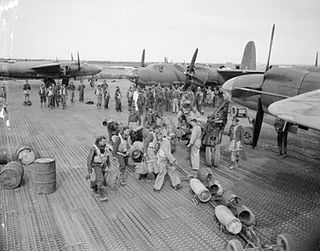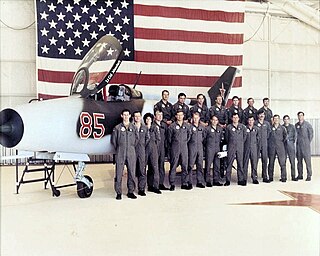 W
W6 Squadron was a South African Air Force unit first formed just before World War II. It was disbanded and re-created a number of times, until finally disbanded in October 1990.
 W
W12 Squadron was a South African Air Force squadron that served in the Second World War in East Africa and the Western Desert as a medium bomber squadron. After the war, the squadron was used in various roles, including that of a helicopter squadron until 1963 when it was equipped with Canberra light bombers, remaining a light bomber and reconnaissance squadron until disbanded in 1990.
 W
W25 Squadron was a maritime patrol and later medium bomber squadron of the South African Air Force during World War II. It was re-constituted twice between 1951 and 1990 as a medium transport squadron and was finally disbanded in October 1990.
 W
WThe 25th Air Division is an inactive United States Air Force intermediate echelon command and control organization. It was last assigned to First Air Force, Tactical Air Command (ADTAC). It was inactivated on 30 September 1990 at McChord Air Force Base, Washington.
 W
W27 Squadron was established as a World War II maritime patrol squadron of the South African Air Force. It was disbanded after the war and resurrected in the same role from 1951 to 1958. Its final period of service was from 1962 to 1990 when it was finally disbanded when its Piaggio Albatross aircraft were de-commissioned.
 W
WThe 50th Red Banner Rocket Army was an army of the Soviet, later Russian Strategic Rocket Forces. It was created in 1960. Its first commander was General Lieutenant Feodor Dobish. Its headquarters was located in Smolensk.
 W
WThe 4477th Test and Evaluation Squadron was a squadron in the United States Air Force under the claimancy of the Tactical Air Command (TAC). It is currently inactive. The product of Project Constant Peg, the unit was created to expose the tactical air forces to the flight characteristics of fighter aircraft used by Soviet Union during the Cold War. The declassified history of the squadron shows that it operated MiG-17s, MiG-21s and MiG-23s between 1977 and 1988, but it was not formally disbanded until July 1990.
 W
WThe Air Forces of the National People's Army was the Air Force of East Germany. As with the Landstreitkräfte, the Volksmarine, and the Border Troops, it was a military branch of the National People's Army (NVA).
 W
WThe Albanian People's Army was the national army of the People's Socialist Republic of Albania from 1946 to 1990. It took part in the Warsaw Pact until it withdrew in 1968. It was dissolved in 1990 and retained its current form through the Albanian Armed Forces. It consisted of the Ground Forces, the Navy and the Air Force. The Militia of Albania was People's Volunteer Guard.
 W
WThe Asas De Portugal was a flight demonstration team created in 1977 integrated with Esquadra 103 of the Portuguese Air Force. It was Portugal's national aerobatic flying team and flew two ex-German Air Force Dassault-Breguet/Dornier Alpha Jets.
 W
WThe Australian Services Contingent was the Australian Army contribution to the United Nations Transition Assistance Group (UNTAG) peacekeeping mission to Namibia in 1989 and 1990. Australia sent two contingents of over 300 engineers each to assist the Special Representative of the Secretary General, Martti Ahtisaari, in overseeing free and fair elections in Namibia for a Constituent Assembly in what was the largest deployment of Australian troops since the Vietnam War.
 W
WThe Felix Dzerzhinsky Guards Regiment was the paramilitary wing of the Ministry for State Security (Stasi), the security service of the German Democratic Republic (GDR).
 W
WThe Friedrich Engels Guards Regiment was a special guard unit of the East German National People's Army (NVA). The regiment was named after Friedrich Engels, the German socialist that collaborated with Karl Marx in systematizing Marxism.
 W
WThe Guard Regiment Hugo Eberlein, officially Wachregiment "Hugo Eberlein" and also known as NVA Wachregiment 2, was a military unit which provided security to the East German Ministry of National Defence. It was formed in 1956 as the Wachregiment der Hauptverwaltung Ausbildung. It had its location at the East German Ministry of National Defence in Strausberg suburb near Berlin. The regiment was named after the Communist Hugo Eberlein, a victim of Stalin's purges.
 W
WThe Kommando Landstreitkräfte was the Army staff — and simultaneously the Army command of the National People's Army (NPA) Land Forces of the former GDR.
 W
WThe Land Forces of the National People's Army, was the ground-based military branch of the German Democratic Republic (GDR) National People's Army (NPA). The Land Forces Command, located at Geltow was established on 1 December 1972 as a management body created for the land forces. The NPA itself was created on March 1, 1956 from the Kasernierte Volkspolizei.
 W
WThe Militär-Helikopter-Rettungsdienst (MHR) was a helicopter unit of the Swiss Air Force, and belonged to the Überwachungsgeschwader. It had professional military pilots and militia part-time pilots. Its main task was to provide air medical services for the Swiss military. At the time of its dissolution the MHR was based at Dübendorf Air Base.
 W
WThe National People's Army was the armed forces of the Socialist Unity Party of Germany and the nation of the German Democratic Republic (GDR) from 1956 to 1990.
 W
WRegiment Groot Karoo was an infantry battalion of the South African Army. As a reserve force unit, it had a status roughly equivalent to that of a British Army Reserve or United States Army National Guard unit.
 W
WMarine Tactical Reconnaissance Squadron 3 (VMFP-3) was an aviation unit of the United States Marine Corps active between 1975 and 1990.